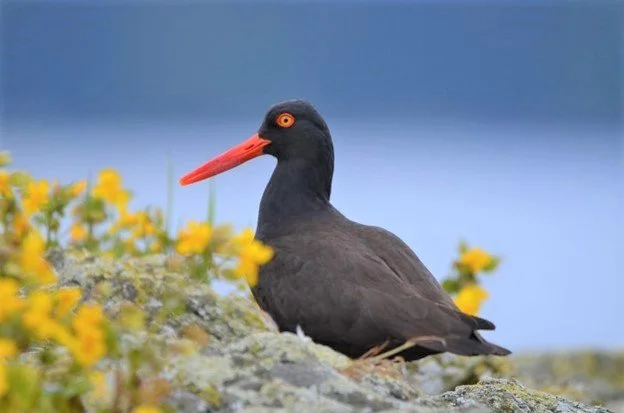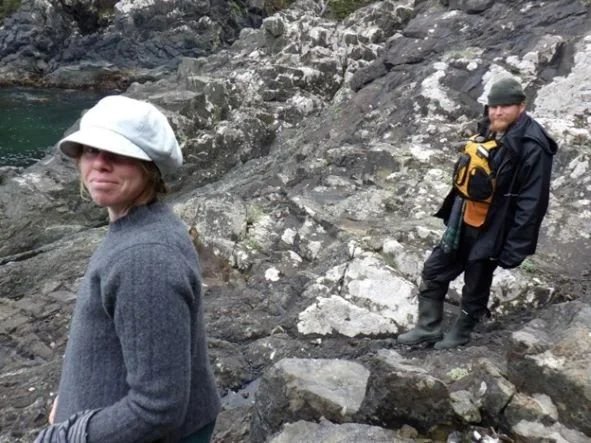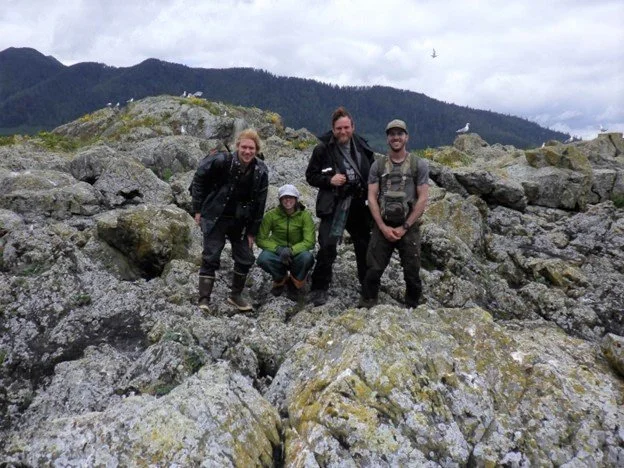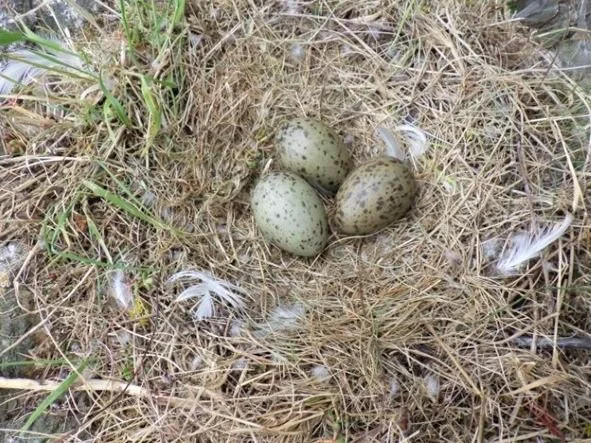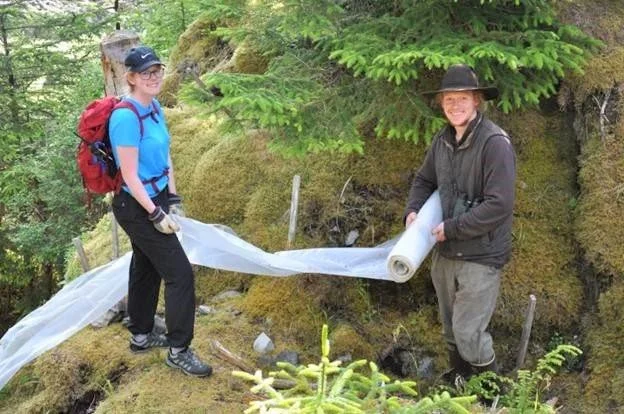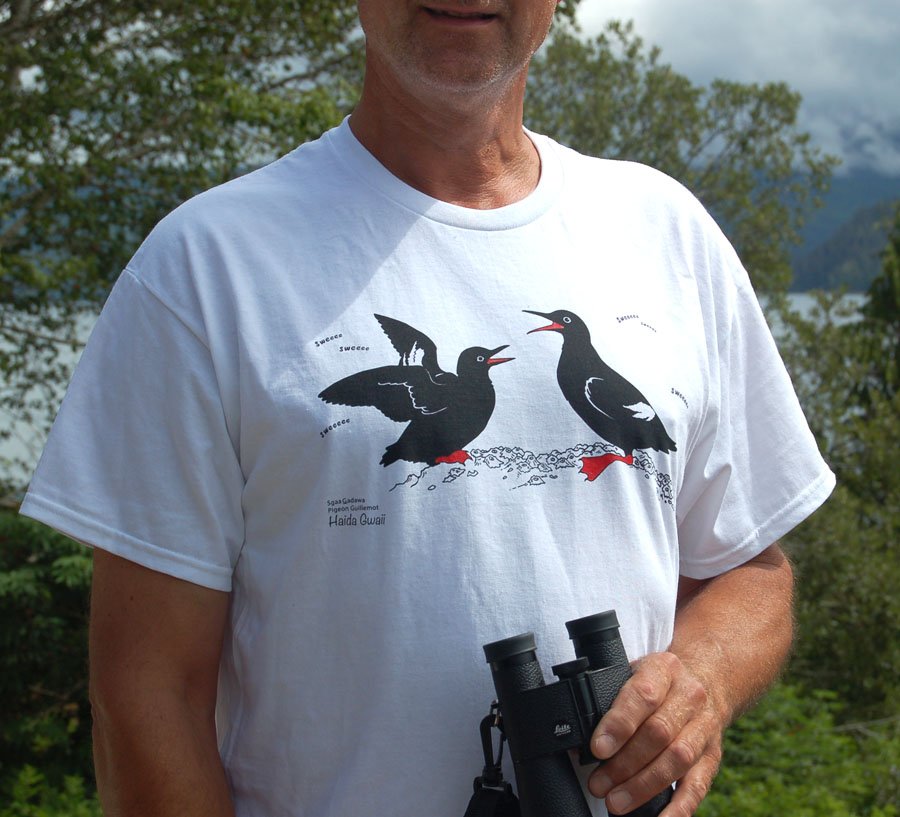July 2022 Limestone Log, and to see our cool new Pigeon Guillemot t-shirt design!
Welcome to our fourth Limestone Log of the 2022 Field Season!
Welcome, as the field crew enters week nine. Weeks seven and eight have been busy but also spectacular, as usual. Every week on East Limestone Island is inspiring, and these last two have been no different. Our field season steams on with our multitude of programs, and we are among friends in camp, as always. The weather has been pleasant, and we continue to learn about and contribute to our fragile ecosystem. Thank you to the K’uuna watchmen for being such great neighbours week after week.
Black Oystercatcher Surveys
BLOY on!
The first round of Black Oystercatcher (BLOY) surveys wrapped up during week seven; mother nature provided us with ideal sea conditions for the exposed boat work involved during the Reef Island section, and for that we are thankful. We will revisit all the scrapes (nests) in July, and hopefully there will be as many chicks as there were eggs!
Kingsway Rock
In addition to the BLOY surveys, we also surveyed select areas for Glaucous-Winged Gull (GWGU) nests. Kingsway Rock is one of the most dynamic sites, as it is relatively small in area, heavily vegetated with flowers, and densely populated with nesting GWGUs, BLOYs, and Pigeon Guillemots (PIGU). A sweep of the islet revealed 53 GWGU nests and at least 145 GWGU adults. Comprising the 53 nests were a total of 124 eggs and 16 chicks. Our discoveries were not without some aerial attacks by the gulls, some of which contacted their targets (us), yet everyone managed to escape without being painted white. In addition to the gull nests there were seven active BLOY scrapes (some with chicks as well), and at least one PIGU nest.
Gulls tend to have a bad reputation, particularly in the urban environment. However, it is worth taking some time to enjoy gulls in their natural environment whenever possible, as they are an entertaining and interesting bird to observe. Andrew Jacobs has been the intern here for the last four weeks, and we will sadly say farewell on July 1st. Andrew has brought with him a charismatic and bottomless positive energy, and in particular an insatiable love of gulls. Thank you, Andrew, for your love of gulls and birds in general. Until next time.
Welcome back, Tony Gaston!
Week eight’s crew changeover brought Tess Hendaoui (local volunteer), Megan Scott (incoming student intern), and Dr. Anthony Gaston. Due to the ongoing global pandemic, Tony has been unable to return to East Limestone Island for the last two seasons. Since 1990, when he was one of the founders of Laskeek Bay Conservation Society, Tony has visited East Limestone Island numerous times to participate as volunteer, guide, and advisor with the field program. His knowledge of seabirds is extensive, as are his professional and life experiences and we are extremely fortunate and grateful to have him with us in camp for weeks eight and nine to offer his insights and share his observations.
Ancient Murrelet Chick Funnels
Week 8 was our final week of Ancient Murrelet (ANMU) chick funnels. While we did not have record-breaking numbers of chicks exiting funnels on camera this year, we remain optimistic about the local ANMU presence; between June 17-28 we observed 366 adults within Laskeek Bay. Furthermore, Fork-tailed Storm-Petrels have been quite lively in and around our camp. Andrew and Jesse crept around camp with a game camera between 1:30-3:00am, which has been the time of peak activity. Although they did not capture any magazine-grade photos, they did manage to point the camera in the general direction of the witch-like laughing calls and capture a distinctive blur (Figure 10).
Another notable resident we have managed to photograph is the Cassin’s Auklet (CAAU) (Figure 11). Near the lookout blind, a CAAU has nestled into a small cave at the base of the cliff. CAAU burrows are notoriously smelly; they feed their chicks regurgitated plankton, which is not a choice aroma. Another burrow nearby is awaiting a captured photo, as there is some suspicion of a Rhinoceros Auklet (RHAU) burrow. On our most recent sea survey, we encountered a bait ball where at least 70 eagles, a minke whale, and an estimated 700 RHAU were feeding on unidentified fish. More great news for Laskeek Bay.
Marine Mammals
Week eight has also been active for marine mammals: we’ve managed to see Harbour Porpoises, Harbour Seals, Steller’s Sea Lions, Humpback and Minke whales, and Orcas. A pod of four Orcas has been visiting Laskeek Bay fairly regularly. As often as we can, we try to capture identification photos of the dorsal fins and flukes of whales. Sometimes it is opportunistic and relatively easy to get these photos, as we may be on the boat already. Sometimes we are incredibly lucky, and the Orcas visit the kelp beds right along the shoreline in front of camp (as happened this week). However, sometimes they make us work for the photos, as was the case on Tuesday. We overheard on the VHF radio that there were Orcas operating nearby, and so Matt, Andrew, and Megan ran across Limestone Island to Boat Cove, hopped in the boat, and set out for ID pictures. After sighting the Orcas in the distance, the whales suddenly disappeared, causing the researchers to nearly lose hope but after a little perseverance, some good fortune, and a good eye, a flock of gulls in the distance indicated possible Orca presence. Sure enough, they had transited across the bay to the Skedans Islands where the team followed them to the Sea Lion haul out and succeeded in capturing some great ID shots. Hopefully we will have some answers as to who specifically has been visiting us! *No Sea Lions were harmed in the making of this Limestone Log.
Wildlife Trees, Chicks, and Fledglings
As of the 2022 field season we have identified and monitored a total of 194 wildlife trees over the years on East Limestone Island. This season we managed to locate 18 active wildlife trees, four of which were never active before (to our knowledge), one Raven nest (4 chicks), one Bald Eagle nest (still active), and a potential Peregrine Falcon eyrie (chicks not spotted yet). In addition to the cavity nesters, a Dark-eyed Junco, Orange-crowned Warbler, Hermit Thrush, and Townsend’s Warbler nest were located. Songbird nests are quite discreet, so it is safe to say there were many other nests that we did not locate, particularly considering the large number of Golden-crowned Kinglet chicks that are around! This week, our last cavity nester fledged: the Tree Swallow. Before this week, all the Red-breasted Sapsuckers, Hairy Woodpeckers, and Chestnut-backed Chickadees had fledged. While it is sad to wrap up our Wildlife Tree monitoring program, we are pleased to know that East Limestone Island had another great year for cavity nesters.
A note from Tony Gaston:
My first trip to East Limestone Island was in 1983 when I joined a Canadian Wildlife Service team camping at Vertical Point to look at work they were doing to census seabirds in the area. I was immediately attracted to the Ancient Murrelet as a species about which relatively little was known and one with a very unique life history and I decided to return the following year to start a study of their biology and demography on Reef Island. After six years of intensive studies at Reef Island, the CWS project was terminated, but the Laskeek Bay Conservation Society was born out of the ashes, almost literally, as we burnt the cabin on Reef Island in 1989 but recycled the doors and windows to the new cabin created on East Limestone Island in 1990.
Since then, East Limestone Island has changed dramatically. The Ancient Murrelet population, which numbered in the thousands in the 1970s, had shrunk to about 1500 by 1990 and sadly, despite our efforts to control raccoons, continued to decline throughout the later years, with the large blowdown event of 2010 putting the nail in the coffin: probably less than 100 breeding pairs remain. The blowdown transformed the former old-growth cover from vertical to horizontal, causing an enormous burst of regeneration, mainly by Sitka Spruce, and providing extensive habitat for otherwise heavily deer browsed shrubs, such as Ribes (currant species), Rubus (Salmonberry and Thimbleberry), and Red Elderberry to flourish on upturned root masses and broken stumps. We are monitoring the vegetation changes resulting from the blowdown and the associated changes to land-bird populations, with Orange-crowned Warblers, Fox and Song sparrows and probably Sooty Grouse benefitting from the new habitat created. The blowdown has reminded us that these coastal forests are extremely dynamic, with both fauna and flora shifting periodically with changes to the forest structure, emphasizing the need to keep substantial areas unlogged to maintain natural processes. We look forward to continuing our monitoring and tracking the trajectory of the forest vegetation and associated birds.
Thanks!
Thanks to volunteers Klare Yakabuski and Tess Hendaoui for all your hard work during these two weeks! And thanks to student intern Andrew Jacobs for spending four weeks at Limestone Island, helping with all facets of our monitoring programs.
"Tricky Trivia"
Answer to the previous trivia question:
This was a pretty challenging question - cormorants can be tricky to ID! The birds circled in red are Brandt’s Cormorants while the others are Pelagic Cormorants. Brandt’s Cormorants are larger, with a more rounded head and a relatively heavier, more hooked bill. In good lighting, you may be able to see tan feathers at the base on the bill on Brandt’s Cormorants while Pelagic Cormorants have an all-black face.
NEXT Trivia Question:
People have introduced several mammal species to Haida Gwaii since 1900. Which of these species is native to the archipelago: Sitka black-tailed deer, Raccoon, River Otter, Roosevelt Elk, Beaver, Black Rat, Muskrat, or Red Squirrel?
See upcoming Limestone Log - Issue 5 for the answer!
Check out our newest T-shirt Design featuring the elegant Pigeon Guillemot!
If you are a local resident or current visitor on Haida Gwaii - come visit our booth at upcoming Skidegate Days - July 23, on the front street in Skidegate. T-shirts are $30, cash or e-transfer.
These t-shirts will also be available for purchase via our website. The design is by local artist and Laskeek Executive Director, Judy Hilgemann.
Follow us on facebook for more Limestone Adventures!
Our user name is Eli Laskeek Seabird.
The Laskeek team would like to send out a big HAAWA & THANK YOU to our sponsors and supporters who have made our projects possible: Gwaii Trust, B.C. Gaming, Northern Savings Credit Union, Bluewater Adventure Tours, and Canadian Wildlife Service.
We are happy to report that the Laskeek Bay Conservation Society is now wrapping up a successful season of volunteers, tour groups, and community events planned. Stay tuned for one more Limestone Log, and a Field Season Summary, coming soon.
Donations to support our ongoing programs remain crucial to our continued success - please click on the Donate Now button below, to be taken to our website donation page.


